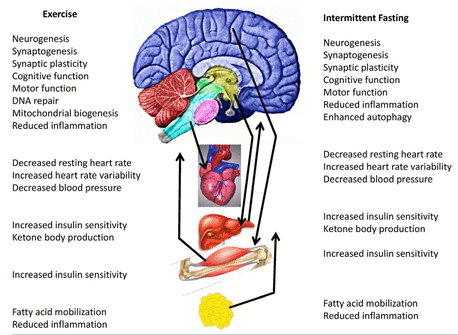I have had numerous requests for a PDF of the article referenced in a Dec. 29, 2014 post - on how exercise and fasting stimulate brain plasticity and resilience - with the same title as this post. It turns out that the reference pointed to by the link is open source. Readers should be able to download the article for themselves. Here is the text of the original post:
I thought it might be useful to point to this brief review by Praag et al. that references several recent pieces of work presented at a recent Soc. for Neuroscience Meeting symposium. The experiments indicate that exercise and intermittent energy restriction/fasting may optimize brain function and forestall metabolic and neurodegenerative diseases by enhancing neurogenesis, synaptic plasticity and neuronal stress robustness. (Motivated readers can obtain the article from me.) Here is their central summary figure:

Exercise and IER/fasting exert complex integrated adaptive responses in the brain and peripheral tissues involved in energy metabolism. As described in the text, both exercise and IER enhance neuroplasticity and resistance of the brain to injury and disease. Some of the effects of exercise and IER on peripheral organs are mediated by the brain, including increased parasympathetic regulation of heart rate and increased insulin sensitivity of liver and muscle cells. In turn, peripheral tissues may respond to exercise and IER by producing factors that bolster neuronal bioenergetics and brain function. Examples include the following: mobilization of fatty acids in adipose cells and production of ketone bodies in the liver; production of muscle-derived neuroactive factors, such as irisin; and production of as yet unidentified neuroprotective "preconditioning factors." Suppression of local inflammation in tissues throughout the body and the nervous system likely contributes to prevention and reversal of many different chronic disease processes.

